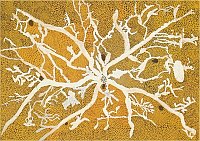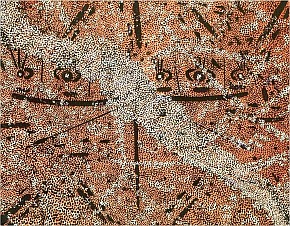Fig. 1: Tim Leura Tjapaltjarri, Yam Spirit Tjukurrpa, 1972, Holz, 54 x 70 cm, printed in: Bardon, Geoffrey: Papunya Tula. Art of the Western Desert, McPhee Gribble, Melbourne 1991, p. 120
Fig. 2: Tim Leura Tjapaltjarri, Seven Sisters Tjukurrpa, 1973, Acryl auf
Holz,
printed in: Benjamin, Roger and Weislogel, Andrew C. (eds.):
Icons of the Desert: Early Aboriginal Paintings from Papunya,
Herbert F. Johnson Museum of Art, Cornell University, New York
2009, p. 32
The Spiritual Relationship to Country
and to Secular Narration
 Tim Leura Tjapaltjarri painted a series of six artworks on the theme “Yam Spirit”, an important source of nourishment in the Australian outback. In the artwork shown here, alongside a representation of the tuber system of the yam are added symbols for people and animals: dingos, a crow, women carrying wooden containers, warriors with speers and shields etc. The figures are painted in the same white colour as the yam plant so as to suggest that both possess the same spiritual importance. It is rare that a painting portrays the inseparable spiritual connection between people, country, plants and animals in such clarity, discernible even by non-Indigenous viewers. The surfaces with light-coloured dots show grass, the darker areas indicate areas burnt off by carefully lit fires in the search for the yam tubers.
Tim Leura Tjapaltjarri painted a series of six artworks on the theme “Yam Spirit”, an important source of nourishment in the Australian outback. In the artwork shown here, alongside a representation of the tuber system of the yam are added symbols for people and animals: dingos, a crow, women carrying wooden containers, warriors with speers and shields etc. The figures are painted in the same white colour as the yam plant so as to suggest that both possess the same spiritual importance. It is rare that a painting portrays the inseparable spiritual connection between people, country, plants and animals in such clarity, discernible even by non-Indigenous viewers. The surfaces with light-coloured dots show grass, the darker areas indicate areas burnt off by carefully lit fires in the search for the yam tubers.
The spiritual connection between people and their complete environment is communicated to the viewer in the form of secular narratives. These transmit knowledge such as the rules of interaction in society, and – in their entirety and deepest meanings, which are not communicated to outsiders – they represent the total world view (metaphysics) of the Indigenous Australians, the Tjukurrpa (1). The work “Seven Sisters Tjukurrpa”, painted in 1973 by Tim Leura Tjapaltjarri, and its associated information may serve as an example and is described below.
 A man had married seven sisters. One morning he went out hunting in a part of the country where there are many cliffs and he killed a kangaroo. The scent of the dead animal attracted the attention of a spiritual ancestor, a giant, who killed the hunter with his spear. It cooked the kangaroo and the hunter, then went to the seven women and gave them the food to eat. They immediately became ill. As they became aware of what they had eaten, they avenged themselves by preparing a poison, which the giant drank. It became very ill and died. The seven sisters flew into the night sky, with the aid of the ceremonial yam stick, where they have remained for all times as stars, the Pleiads.
A man had married seven sisters. One morning he went out hunting in a part of the country where there are many cliffs and he killed a kangaroo. The scent of the dead animal attracted the attention of a spiritual ancestor, a giant, who killed the hunter with his spear. It cooked the kangaroo and the hunter, then went to the seven women and gave them the food to eat. They immediately became ill. As they became aware of what they had eaten, they avenged themselves by preparing a poison, which the giant drank. It became very ill and died. The seven sisters flew into the night sky, with the aid of the ceremonial yam stick, where they have remained for all times as stars, the Pleiads.
The Seven Sisters Tjukurrpa is an oral tradition, which exists in many different variations from Wirrimanu (Balgo) in northwestern Australia down to the more than 2000 km distant Murray River in South Australia. It recounts an important marriage taboo; and is therefore especially gruesome.
In the painting the ceremonial aspect is emphasized by the positioning of the yam plant in the upper center. The role of the heavens is made abundantly obvious by the superpositioning of the Milky Way diagonally across the painting.
Notes
(1) The spelling of the word Tjukurrpa varies depending upon the Indigenous language referenced: for the Pintupi people, Tjukurrpa, for the Warlpiri, Jukurrpa.
